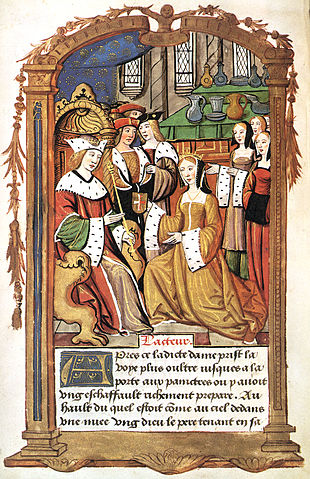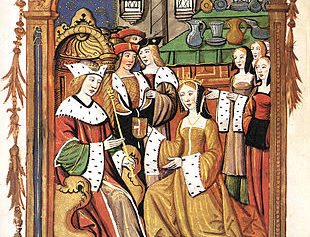
Mary became Queen of France upon her October 9 marriage to Louis XII of France, but the formal coronation took place almost a month later at the Basilica of Saint Denis, a large medieval abbey church that was the traditional location for crowning consorts (the King regnant was more properly annointed with the Crown of Charlemagne at Rheims, much further away). It was also the traditional location for burying kings (all but three of the French kings from tenth century through 1789 are interred there), but that’s a different story…
Mary arrived at St. Denis on November 3, staying there overnight before the coronation (much like English monarchs sleep in the Tower the night before theirs). She slept there again after the ceremony, so that she could enter Paris in full triumphal procession on November 5. This procession was a carefully managed ceremony full of images and personifications of peace, stability and fertility, and meant to impress on the viewing public the benefits of royal government and the presence and splendor of the monarchy. True street theater, its designer was none other than Pierre Gringoire, a popular French poet and playwright.
Gringoire also provided a full account of the procession. I won’t give all the details (it is a good ten pages long!) but I do want to give some of the flavor. He tells us it began at the Porte Saint Denis on the pont levis (drawbridge) where there was “a scaffold hung with rich tapestry, on which stood a ship of three tops (hunes), with masts and sails complete; and round it were the four principal winds, as if blowing it. Within were Bacchus and Ceres, holding respectively a vine-branch covered with grapes and a sheaf of corn. A personage named Paris held the tiller. On the main mast stood Honor, holding the arms of France, and on the other masts two men armed with darts, signifying that they would guard the honor of the said ship. In the rigging stood mariners singing […] verses.”
Other stops included the Fountain du Ponceau (where a lily and a red rose floated in the fountain and three women, representing the three graces, stood in front); then La Trinite (where the Queen of Saba appeared before Solomon); then the Porte aux Peintres (which featured a three-level pageant, with God at the top, a man and woman representing Louis and Mary in the middle, then five female figures representing France and England with peace, amity and confederation standing between them); then the Church of the Holy Innocents (another multi-level pageant); then Chatelet, which was the seat of royal justice; and finally the Royal Palace.
Throughout, the iconography related Mary Tudor to the Virgin Mary – of course the hope was that she would bring an heir to the son-less monarch – and expressed enormous hopes and aspirations for the new King and his Queen. As Michael Sherman puts it so eloquently, “The pageants for Mary Tudor are, in fact, a masterful union of ceremonies and circumstances, an expression of the political opportunities, aspirations and values shared by a society and represented by the immediate, the symbolic, and the implied presence of that society’s leading figures.” PR at its best.
SOURCES
Wikipedia has wonderful articles about Saint-Denis (check out the photos they’ve included!)
You can read a summary of Gringoire’s account in Letters & Papers. But if you want to read more about Gringoire and pursue in-depth descriptions of the pageantry and the symbolism behind it, read the wonderful article by Michael Sherman, “Pomp and Circumstances: Pageantry, Politics and Propaganda in France during the Reign of Louis XII 1498-1515” from The Sixteenth Century Journal Vol. 9, No. 4 (Winter 1978).
***
If you like my posts, you’ll love my books! My Seymour Saga trilogy tells the gripping story of the short-lived dynasty that shaped the Tudor Era. Jane the Quene skews romantic, The Path to Somerset is pure Game of Thrones (without the dragons), and The Boy King is a noir coming-of-age. Get them now through Amazon, Barnes & Noble, Kobo, and Apple, or even your local independent bookstore!

(PS Already read them? Did you love them? Then please review them – even just a stars rating! It makes a huge difference in helping new readers find them and would mean the world to me!)

[…] Janet Wertman: AQUI. Hall, […]
[…] She was crowned on November 4, 1514 in a magnificent display of pomp (I wrote a blog post about it, you can read it here) and all of France hoped for an heir. Unfortunately, three months after the wedding the only thing […]
[…] Janet Wertman: AQUI. Hall, […]
Sorry to be such a pain, but she was crowned Queen on the 5th, not the 4th. xx (Letters & Papers Vol 1 3424.)
Thank you, the article is very useful